Charleston Airport's Newest Employee
Russ Kennedy, Yeager Airport, Charleston, WVA
 Russ Kennedy holds down security at Charleston's Yeager Airport. He's also the handler for Greg, a border collie that clears runways from geese and other wildlife that could cause a fatal aircraft accident.
Russ Kennedy holds down security at Charleston's Yeager Airport. He's also the handler for Greg, a border collie that clears runways from geese and other wildlife that could cause a fatal aircraft accident.
Russ Kennedy is the Airport Response Coordination Center Duty Officer. He's also the Assistant Airport Security and he's part of the BASH (Bird & Wildlife Strike Hazard) Team. Part of Russ' job is getting rid of birds and wildlife off the runways. This is so that planes don't hit them or they don't get sucked into the engines resulting in accidents. But he doesn't do this job alone; he has a brand new partner to help him.
Russ' partner is a four-year-old Border Collie named Greg. He is on loan from a company out of North Carolina called, "Fly Away Geese." Basically, Greg is teaching Russ how to do the job. Greg will be on hand until the airport gets their own full-time Border Collie named Hercules, who is a year and a half old. Hercules was named after the C-130's that shared the airfield with them with the 130th Airlift Wing.
Basically the job of these dogs is to chase the wildlife off the air strip to keep them from getting ingested into an aircraft, or possibly striking a windshield or anything else that would create damage to the aircraft or the passengers on the commercial airlines.
However, you won't see Greg just running around outside of the airport chasing birds and other wildlife. There is an actual vehicle that Greg rides in. Greg is driven out to the airfield when they look for animals.
Greg is trained in the same aspects of a Border Collie who would herd sheep. They have specific commands that they can give him out on the airfield to push animals left, right and even forward. Russ says Greg is almost like a remote control.
They also use Greg to run geese off of a local park that's right in the flight path. It's down the hill from the airport and has a pond that the geese and ducks will congregate in. Greg actually loves to swim and will chase the birds out of the water so they will fly away.
Does ever try to catch any of the wildlife? No. Being a Border Collie, his instinct isn't to hurt. Russ says Greg is PETA friendly and he just wants to herd the animals. He doesn't want to hurt them.
Along with birds, rabbits are also a problem because they are the prey of some birds. Russ explains that there are several raptor species in the area, and with Greg pushing the rabbits outside of the fence area, the birds away from the air surfaces and stay out of the way from the airfield and away from the aircraft.
So what made the Yeager Airport decide to get a runway dog? Do they have a big problem there with birds and wildlife on the runaways? Russ tells us that they don't really have a huge issue with them, they are just being more proactive.
The airport has teamed up with the USDA's Wildlife Management Team and the Bird & Wildlife Strike Airstrike Hazard (BASH) program. Basically, the USDA's Wildlife Management Team brought up the idea of the Border Collies that have been immensely used on golf courses to harass geese and ducks out of their water hazards and ponds. The ideal was that if they can be used at golf courses to get rid of the geese and ducks, why couldn't they be used at airports and military installations to move the wildlife out of areas that they shouldn't be in.
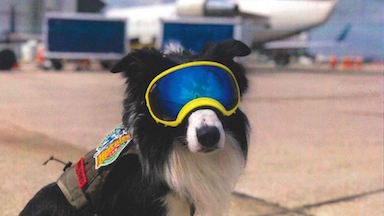 In working with Greg, Russ has learned that he is very intelligent. He's the reason they brought Greg to the airport prior to Hercules coming on board. With Greg being four years old and being well versed in how to do his job, he is actually teaching Russ what to look for once Hercules gets there. With Hercules' being a year and a half, he's going to be a little more of a pup. He's going to be a little more energetic. Greg is showing Russ this is how Hercules should act once he gets here. That way Russ can know the difference between a good reaction and a bad reaction so they can correct Hercules as need be if he's doing something he shouldn't be.
In working with Greg, Russ has learned that he is very intelligent. He's the reason they brought Greg to the airport prior to Hercules coming on board. With Greg being four years old and being well versed in how to do his job, he is actually teaching Russ what to look for once Hercules gets there. With Hercules' being a year and a half, he's going to be a little more of a pup. He's going to be a little more energetic. Greg is showing Russ this is how Hercules should act once he gets here. That way Russ can know the difference between a good reaction and a bad reaction so they can correct Hercules as need be if he's doing something he shouldn't be.
Greg will actually stay on at the airport for about two weeks once Hercules comes on board and Russ will work with both of them. Hercules is basically going learn from Greg. Greg is going to teach him the ropes of being at Yeager Airport specifically,
It can cost anywhere from $10,00 and upwards to train these dogs. Usually they work about 8 to 10 years, but it really depends upon the dogs themselves. Russ will be working hand in hand with a local veterinarian that will keep on Hercules' health. In around eight years if Hercules is still working well, he's got all his health and he's not showing any signs of aging, they may be able to work him a little longer. But if there comes a point that the veterinarian says he's reached his maximum years, then they'll retire him.
It's no coincidence that both Greg and Hercules are males. It turns out that male dogs are generally sent to airports and military installations due to the fact that the male dogs they use are "in tact," which means that they have not been neutered. Un-neutered dogs tend to mark their territories more than neutered dogs. So when they mark their territory, the birds and the other animals don't know the difference between a dog and a wolf or a coyote. All they smell is a predator in their territory.
When the actual coyotes and other wild dogs then mark their own territories over these working dogs, the dogs will of course go back and then mark over the coyotes. This cycle will continue and eventually the birds will get tired of their territory being encroached on and they will find somewhere else to go.
The other animals, like rabbits, will also get tired of being harassed. They will not be provided any food and when they are constantly being harassed by what they feel is a predator, they're also going to go find somewhere else to go.
In the evenings when the dogs are not working, they stay at the airport. When Hercules arrives, he will have his own room and board. Hercules will have a schedule that will put him to bed around 11:00pm. While in bed, he will be in his own room with the lights out and doors closed. There will be no stimulation as far as visual or scents area concerned. This way he gets a good eight hours worth of rest. In the mornings, Monday through Friday when Russ arrives, he will get him out of his room, go out on the airfield and work. Hercules will then get Saturdays and Sundays off. This will allow him to sit around and to play fetch just like a regular dog.
Russ explains that most airports don't have these types of working dogs at this time. This is mostly due to the expense and the unavailability of trained dogs. However, with the USDA Wildlife backing the programs, you're probably going to see a lot more.
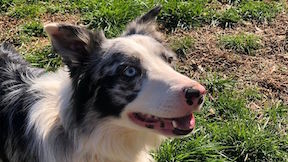 The first well-known airfield dog was Piper. And just like Yeager Airport is doing with Greg, Piper was a big public relations boost. People love to see dogs, so the airlines will announce that Greg is about to go out and do his job and where he's going to be.
The first well-known airfield dog was Piper. And just like Yeager Airport is doing with Greg, Piper was a big public relations boost. People love to see dogs, so the airlines will announce that Greg is about to go out and do his job and where he's going to be.
If there's inclement weather, they can also use Greg to kind of calm down passengers. If they have a young child that's never flown before or even an adult that's never flown before, they can take Greg up to the concourse and walk him around the people, as most people love to see a dog.
One of the stories Russ likes to tell is about a passenger who posted on their Facebook page around a month ago that she was having the worst day ever. She was flying out of the airport. It was inclement weather and there were several delays and several cancellations due to the weather up and down the coast. She was going on a short vacation and because of this, she missed her connection and was stuck at Yeager Airport. Unbeknownst to Russ, he walked Greg out into the concourse where she was and just by chance they ended up walking right past her. Greg then went over and said hi. She petted him and it calmed her down. She was like, "You know, you've just made my day a thousand times better!" Then the next thing Russ knows, he was getting a text message from his assistant director that there was a young lady in Concourse C that was not happy. Russ immediately texted him back and said that he met her and that he thinks she's happy now!
You can see pictures of Greg and Hercules on their Instagram and Facebook pages.
Animal Radio Flashback

Bart Simpson Has a Cow
Nancy Cartwright
 Nancy Cartwright really loves animals. She has an entire menagerie at her L.A. ranch. Her prized pet is a fiberglass cow.
Nancy Cartwright really loves animals. She has an entire menagerie at her L.A. ranch. Her prized pet is a fiberglass cow.
Nancy Cartwright is an American actress, voice actress and comedian, and is known for her long-running role as Bart Simpson on the animated television series The Simpsons. Cartwright also voices other characters for the show, including Nelson Muntz, Ralph Wiggum, Todd Flanders and Database.
Nancy was born in Ohio and moved to Hollywood in 1978 and trained alongside voice actor Daws Butler. In 1987, Cartwright auditioned for a role in a series of animated shorts about a dysfunctional family that was to appear on The Tracey Ullman Show. Cartwright intended to audition for the role of Lisa Simpson, the middle child; when she arrived at the audition, she found the role of Bart—Lisa's brother—to be more interesting. Matt Groening, the series' creator, allowed her to audition for Bart and offered her the role on the spot. She voiced Bart for three seasons on The Tracey Ullman Show, and in 1989, the shorts were spun off into a half-hour show called The Simpsons.
Nancy is crazy about her family of animals and lives in a "ranch-style" country house with on an acre with "tons" of pets. Her menagerie includes, 2 dogs, 3 cats and sea horses. However, she states that, "My prized pet would probably be my life-sized, fiberglass Holstein cow, named Milk Dud." She goes on to state that, "She doesn't actually give milk, unfortunately, but I had to do it because of the "Don't have a cow man!" because I decided I should have a cow!"
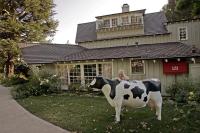 The first pets that she had growing up were Bassett Hounds. She remembers one named Lady, when she was about four years old. When Lady had puppies, they named the one they kept, Pearl. She always had dogs growing up, and doesn't know why they never had cats. However, as soon as she could, she got cats.
The first pets that she had growing up were Bassett Hounds. She remembers one named Lady, when she was about four years old. When Lady had puppies, they named the one they kept, Pearl. She always had dogs growing up, and doesn't know why they never had cats. However, as soon as she could, she got cats.
Nancy mentions that, "I don't know if other kids make this mistake, but when I was growing up, I always thought that dogs were the males and cats were the females," She exclaims, "I don't know how long I went before figuring that one out!"
Despite the fact that she is the most recognizable cartoon voice in the world, Nancy says nobody recognizes her voice in the "real world."
Visit Website
It's Not Doggie Asthma - It's a Reverse Sneeze - Dr. Debbie
 What dog owner hasn't heard that frightening sound that dogs make - part cough, part sneeze and often described as a dog being unable to catch his breath. But it really isn't asthma, or some kind of bone stuck in your dog's throat - it's a reverse sneeze. So before you panic and run into the veterinary office on emergency, ensure you know what a reverse sneeze is.
What dog owner hasn't heard that frightening sound that dogs make - part cough, part sneeze and often described as a dog being unable to catch his breath. But it really isn't asthma, or some kind of bone stuck in your dog's throat - it's a reverse sneeze. So before you panic and run into the veterinary office on emergency, ensure you know what a reverse sneeze is.
Meet the Reverse Sneeze
A reverse sneeze is a respiratory sound in a category all its own. Also known as a pharyngeal gag reflex or backwards sneeze, the reverse sneeze is a commonly observed respiratory sound in dogs, and less commonly in cats. While a true sneeze occurs on the exhale, the reverse sneeze occurs as the dog inhales. The result is a reverberating snorting, wheezing, episodic sound that lasts for a few seconds to a minute or two. A reverse sneeze is a completely harmless sound and dogs do not suffer any immediate health threat from these episodes.
How can you tell it's a reverse sneeze?
There is no easy explanation of the sound - you just have to hear it and you'll recognize it. Click to see and hear an example of a dog's reverse sneeze episode.
Part of my enjoyment on the weekly national radio program, Animal Radio®, is describing the peculiar smells, sounds and essences of veterinary medicine with our listeners. On many an occasion when speaking to callers, I have re-created the sounds of reverse sneezing. I'm no Rich Little, but I do take pride in my impersonation of a canine reverse sneeze, which is admittedly better in person with the visuals to complement the throaty sound.
Characteristics of a dog displaying a reverse sneeze include:
- Vibrational coughing/wheezing sound
- Stiff, extended neck
- Facial grimace
- No discharge from nose
- Not followed by coughing or vomiting up material
- Not involving collapse episodes
- Animal is completely normal after event
What causes a reverse sneeze?
Some reverse sneeze episodes occur when a dog gets very excited or pulls against a leash. Brachycephalic breeds (short faced breeds) like Pugs and Boston terriers commonly display reverse sneezing due to their upper airway conformation.
 Allergies, respiratory infections, nasal mites, inhaled foreign bodies and masses can also trigger reverse sneezing. Dogs with inflammatory conditions such as lymphoplasmacytic rhinitis can also display bouts of reverse sneezing. And sometimes reverse sneezing occurs in the wee hours of the night, while a dog is sleeping, for no apparent reason. In fact, many veterinarians receive panicked phone calls at 2am from pet owners, concerned of impending asthma attacks or respiratory arrest, only to have it turn out just to be a typical case of reverse sneezing.
Allergies, respiratory infections, nasal mites, inhaled foreign bodies and masses can also trigger reverse sneezing. Dogs with inflammatory conditions such as lymphoplasmacytic rhinitis can also display bouts of reverse sneezing. And sometimes reverse sneezing occurs in the wee hours of the night, while a dog is sleeping, for no apparent reason. In fact, many veterinarians receive panicked phone calls at 2am from pet owners, concerned of impending asthma attacks or respiratory arrest, only to have it turn out just to be a typical case of reverse sneezing.
What to Do?
There is no required treatment for a reverse sneeze episode. However, I recommend stroking a dog's throat while gently speaking to him in a calm manner until the episode subsides. Some advocate closing/pinching the nostrils off, which forces a dog to swallow and curtails the reverse sneeze episode. Whatever the approach, reverse sneezing episodes are over within minutes, so no emergency treatment is indicated. Antihistamines may be prescribed to minimize reverse sneezing episodes.
When to Worry?
If all of a sudden your dog is having repeated bouts of reverse sneezing, evaluation by your veterinarian is indicated. Consult with your veterinarian if your dog is reverse sneezing along with other symptoms such as facial rubbing, nasal bleeding, nasal discharge, coughing, or significant sneezing episodes.
Nasal mites are a common cause of reverse sneezing and may be noted after a recent boarding visit, especially if multiple dogs in a household are involved. Nasal mite treatment is easily pursued with anti-parasite injections of ivermectin (or in collie breeds - the alternative Milbemycin.) If reverse sneezing is excessive and prolonged, the nasal and pharyngeal areas should be evaluated by a veterinarian through rhinoscopy - a procedure performed under anesthesia in which the nasal passages and pharyngeal areas are visualized with an endoscope, a micro camera. This is how foreign objects and masses are typically identified. In other cases, further tests may be needed including a CT scan or with biopsy samples from sinus passages.
Final Thought
The good news is that most of reverse sneezing episodes are harmless, and do not indicate any serious illness. Arm yourself with information by learning what a reverse sneeze looks like and you may save yourself an unwanted emergency veterinary visit over this peculiar but non-life threatening occurrence.
Featured veterinarian known as "Dr. Debbie" on national pet radio program, Animal Radio. Ebook author of "Yorkshire Terriers: How to Be Your Dog's Best Friend"; "Pugs: How to Be Your Dog's Best Friend"; "Mini Schnauzers: How to Be Your Dog's Best Friend"; and "Shih Tzu: How to Be Your Dog's Best Friend." Dr. Debbie's books.
Visit Website
Animal Radio News - Lori Brooks
 Counting Cats
Counting Cats
A coalition of animal groups in Washington, D.C., have started the D.C. Cat Count, which will try to create a more accurate estimate of the city's entire cat population, including both feral and pet cats. The project is expected to take three years and will cost $1.5 million. The groups hope the information will help improve efforts to manage the cat population. The project will use many different strategies to arrive at a total population count, including an app allowing residents to snap their own images of cats they encounter.
Bucket List Dog Finds Forever Home
A terminally ill shelter dog has checked off the biggest item on his bucket list: finding a forever home. You might remember Smoke's story about his bucket list and search for a home. Now, the 10-year-old hound mix with advanced cancer has found his forever home.
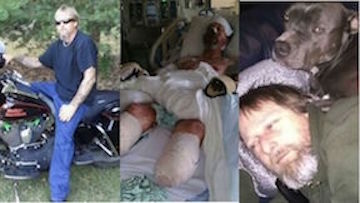 Man's Legs and Hands Amputated After Dog Lick
Man's Legs and Hands Amputated After Dog Lick
Greg Manteufel from Wisconsin had part of his arms and legs amputated after contracting a very rare infection, believed to have been caused by a dog lick. It wasn't just that a dog licked him, but the dog licked an open wound. This led to the very rare blood infection caused by common bacteria called capnocytophaga canimorsus, which is found in the mouths of dogs and cats and even humans. Animal experts jumped on this story right away, saying most people have an extremely small risk of contracting a similar infection from their pet. They also stress it is certainly no reason for anyone to give up a beloved companion. Up to 74-percent of dogs and 57-percent of cats have some form of capnocytophaga in their mouths. Testing your pet for the bacteria won't help, because an animal might have the bacteria one day but not have it the next. It is very rare for humans to contract the infection. In fact, experts don't know exactly how many people are infected with capnocytophaga annually, because there's no agency that keeps a record of cases. Some people are more at risk than others. People who have lost their spleen and people who are immune compromised are more likely to get sick from the bacteria. In fact, experts say a person without a spleen should go to a doctor for any dog bite, even a "little nip" that most people would not need to worry about.
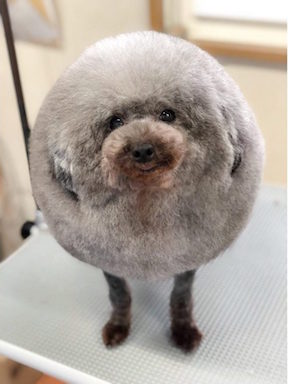 Is It A Dog or a Ball?
Is It A Dog or a Ball?
A dog groomer in Japan is literally turning dogs into fluff balls. Yoriko Hamachiyo is clipping usually small dogs into a ball. He does this by cutting their hair so they look like a soft, fluffy round ball, a ball with legs.
It's Not About the Size - But the Lift When it Comes To Dogs
Dogs can communicate through scent, leaving their mark everywhere. They urinate on new areas, their own home turf and things that other dogs have peed on. Some male dogs lift their legs in order to pee higher. However, new research finds that smaller dogs lift their legs at an even higher angle than larger dogs, perhaps to make themselves appear larger. The study was published in the Journal of Zoology. The researchers from Cornell University first had to establish that the angle a dog raised its leg is a good stand-in for how high the pee goes. They took a bunch of shelter dogs for walks and filmed them peeing with an iPhone, and in some cases, a high-speed camera. Based on their analysis, how high the dog raised its leg could predict how high the pee would go, as could the dog's mass and height. Next, they analyzed how a dog's size compared to how much it lifted its leg. Both lighter and shorter dogs lifted their legs to higher angles than larger dogs. The little dogs seemed to be trying to leave a pee signature of a larger dog. They seem to "cheat" by using higher raised-leg angles to leave higher urine marks, thus exaggerating their size to other dogs that would come along and sniff later.
Pig Halts Robbers
Police in Indiana believe a pet pig is better than a burglar alarm in this case because the rescued pig stopped would-be robbers from burglarizing a home in Indianapolis. Burglars broke into the home but they didn't steal anything. The pig, whose name is Dumplin, apparently surprised the burglars who weren't counting on dealing with a pig inside the house. They ended up leaving without taking anything, though the back door was damaged.
 Listen to the entire Podcast of this show (#976)
Listen to the entire Podcast of this show (#976)





